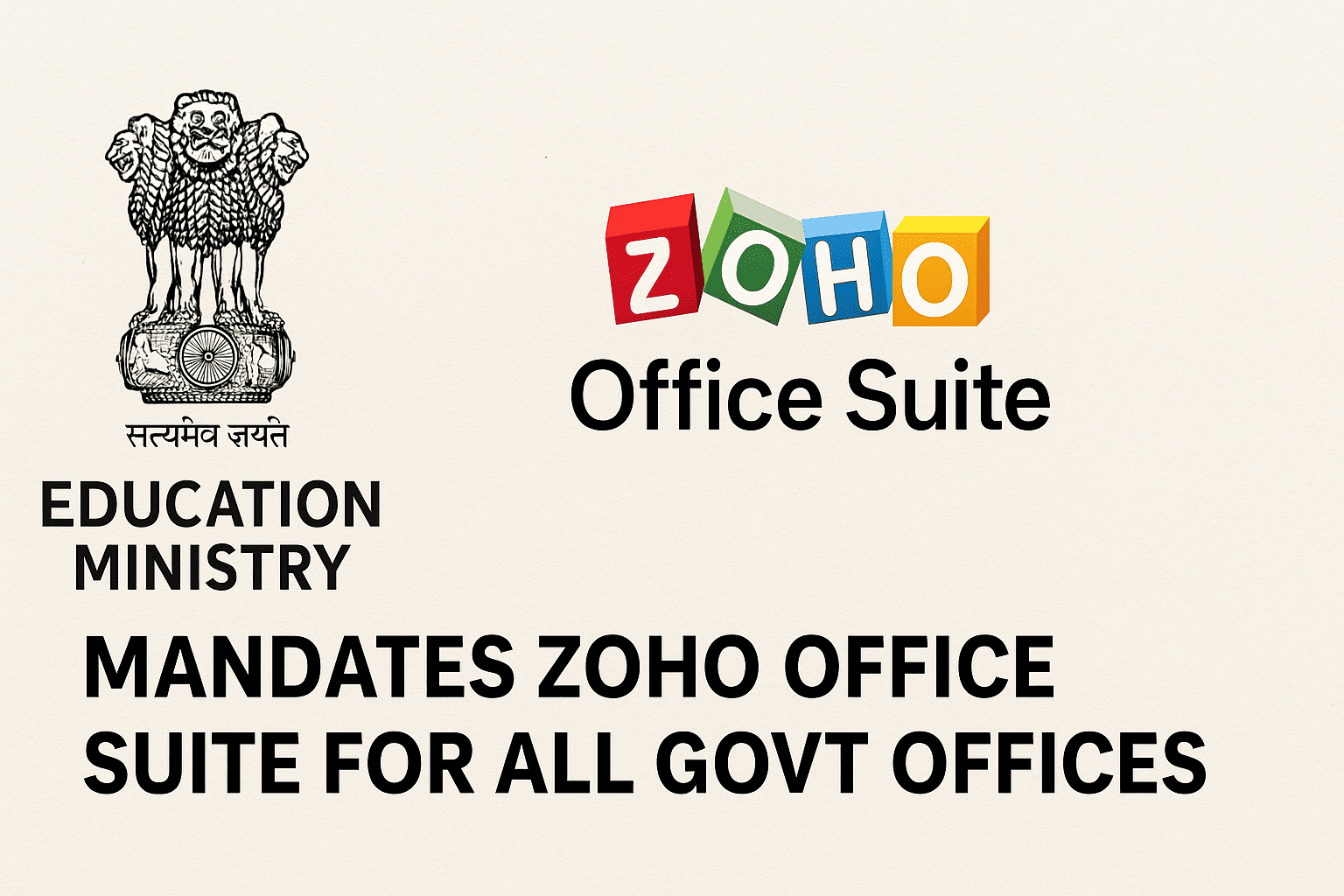Government Offices Embrace Zoho Suite: The Education Ministry's Directive for a Digital Shift
In the heart of India's administrative landscape, a quiet yet profound change is unfolding. On October 3, 2025, the Ministry of Education issued a clear directive: all its departments and personnel must transition to the Zoho Office Suite for handling official paperwork and communications. This order, penned by Under Secretary Nishant Upadhyaya, signals a deliberate pivot toward indigenous technology solutions, aiming to streamline operations while fostering national innovation. For government workers accustomed to familiar international tools, this move represents both a challenge and an opportunity to redefine efficiency in public service.
Who Is Zoho? A Homegrown Tech Powerhouse
At the center of this transition stands Zoho Corporation, a Chennai-based multinational that has quietly built a global reputation over the past three decades. Founded in 1996 by Sridhar Vembu and Tony Thomas, Zoho started as a simple network management tool but evolved into a comprehensive ecosystem of software designed for businesses and organizations worldwide. Unlike many tech giants that rely on venture funding, Zoho remains privately held and consistently profitable, a testament to its bootstrapped ethos and focus on sustainable growth.
Headquartered in India with offices spanning 25 countries, Zoho serves over 80 million users across 150+ nations. Its commitment to privacy—no ads, no data sales—sets it apart in an industry often criticized for invasive practices. Vembu, the CEO, is a vocal advocate for rural development and engineering talent from smaller towns, reflecting the company's roots in empowering underserved communities. Today, Zoho isn't just a vendor; it's a symbol of India's burgeoning software prowess, competing head-on with established players through ingenuity and affordability.
What Does Zoho Do? Tools Tailored for Modern Workflows
Zoho's portfolio is vast, but the Office Suite—now at the forefront of the ministry's mandate—forms its productivity core. This cloud-based collection mirrors everyday essentials like word processing, spreadsheets, and presentations, but with a distinctly collaborative edge. Zoho Writer handles document creation with real-time editing and version tracking, ensuring teams can refine reports without endless email chains. Zoho Sheet crunches data with intuitive formulas and visualizations, ideal for budgeting or student enrollment analytics. Zoho Show, meanwhile, crafts polished slideshows for meetings or policy briefings, complete with embeddable multimedia.
Beyond the basics, the suite integrates seamlessly with Zoho's broader offerings: CRM for managing stakeholder interactions, Mail for secure emailing, and Cliq for instant team chats. All powered by a unified dashboard, these tools emphasize mobility—accessible via web, desktop, or mobile—while prioritizing data sovereignty through servers hosted in India. For government offices, this means handling sensitive records like curriculum plans or grant allocations with built-in compliance features, such as audit logs and role-based access controls. In essence, Zoho doesn't just replicate foreign suites; it enhances them with cost-effective scalability, starting at free tiers for small teams and scaling without hefty licensing fees.
Why Did This Happen? A Calculated Step Toward Self-Sufficiency
While the ministry's order is straightforward, its underlying motivations appear rooted in a broader national strategy. India has long championed "Atmanirbhar Bharat," or self-reliant India, especially in technology amid global supply chain disruptions and data privacy concerns. By 2025, escalating costs from imported software—coupled with geopolitical tensions—prompted a reevaluation of dependencies on U.S.-based providers. The ministry's choice of Zoho aligns with this ethos, promoting "Swadeshi" digital tools that keep economic value within borders and safeguard national data from foreign jurisdictions.
One can reasonably assume practical drivers played a role too. Government IT budgets are stretched thin, and Zoho's pricing—often 30-50% lower than competitors—offers immediate savings. Integration with the National Informatics Centre (NIC) email system, as specified in the directive, minimizes disruption while enhancing cybersecurity. Moreover, high-profile endorsements, such as Union Home Minister Amit Shah's recent adoption of a Zoho email account on October 8, 2025, likely amplified momentum. Shah's public note to colleagues—"Hello everyone, kindly note my new Zoho address"—underscored a top-down push for uniformity. In a year marked by digital transformation initiatives, this order feels like a timely response to calls for equitable tech access, particularly in education where outdated systems have hindered remote learning and administrative agility.
What Lies Ahead? Implementation and Ripple Effects
The directive's rollout begins immediately, with officials tasked to migrate existing documents and train staff over the next quarter. Expect workshops and NIC-led support to ease the switch, focusing on seamless data transfer from legacy platforms. By early 2026, the ministry anticipates full adoption across its 15+ departments, potentially extending to affiliated bodies like universities and regulatory councils.
Looking further, this could cascade beyond education. Other ministries, inspired by the pilot's success, might follow suit—perhaps finance for budgeting tools or health for patient records. Zoho's ecosystem could integrate with emerging government portals, like the Digital India platform, enabling AI-driven analytics for policy decisions. For users, this means faster approvals for student aids or research grants, with collaborative features reducing paperwork backlogs by up to 40%, based on similar transitions in private sectors. Challenges like initial resistance or technical glitches are probable, but phased timelines should mitigate them.
Will It Succeed? A Balanced Outlook on Potential Triumph
Success seems probable, given the mandate's enforceability and Zoho's proven track record. In private enterprises, adoption rates often exceed 90% within six months, thanks to intuitive interfaces and robust support. For government settings, the NIC integration provides a safety net, while cost reductions—estimated at 25% annually—offer tangible incentives. Early feedback from beta testers within the ministry highlights user-friendly design, with minimal learning curves for basic tasks.
That said, hurdles exist. Older staff may balk at change, and rural offices with spotty internet could face delays. Data migration risks, if not handled meticulously, might erode trust initially. Yet, Zoho's decade-long partnerships with Indian enterprises suggest adaptability. If the ministry invests in ongoing training and feedback loops, this could not only succeed but set a precedent, boosting Zoho's domestic market share and inspiring a wave of local tech innovation. By mid-2026, we might see measurable gains: streamlined workflows, enhanced data security, and a stronger digital backbone for education.
This shift isn't merely administrative—it's a narrative of empowerment, where Indian ingenuity takes the reins. As government offices log into Zoho for the first time, they're not just updating software; they're investing in a future where technology serves the nation first.





